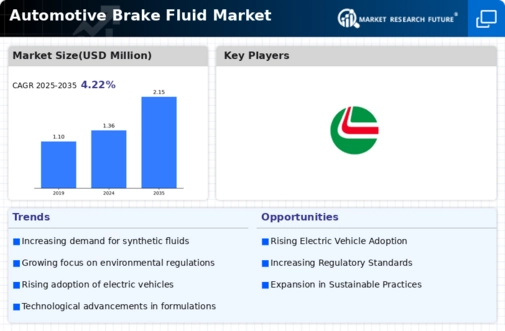Top Industry Leaders in the Automotive Brake Fluid Market
*Disclaimer: List of key companies in no particular order
The automotive brake fluid sector, while often operating behind the scenes, stands as a crucial element in ensuring car safety, thereby constituting a vital segment within the expansive automotive industry. With a consistent market size in the billions and anticipated growth in the forthcoming years, the competitive landscape within this domain is both dynamic and intricate. This exploration aims to dissect the key players, their strategic maneuvers, and the emerging trends that mold this pivotal market.
Key Players and Their Strategies:
Global Giants: Distinguished entities such as TotalEnergies, Bosch, Castrol, ExxonMobil, and BASF wield substantial market shares, leveraging expansive distribution networks, brand recognition, and diversified product portfolios tailored to different vehicle types and DOT specifications. Their strategies typically involve sustained investments in research and development (R&D), strategic collaborations with original equipment manufacturers (OEMs), and assertive marketing endeavors to uphold their preeminent positions.
Regional Specialists: Players like Fuchs Lubricants, Ravenol, and Cosworth, operating at a regional level, engage in intense competition by offering specialized products with competitive pricing. They capitalize on their profound regional insights and close ties with local workshops and distributors to infiltrate targeted segments.
Niche Players: Smaller enterprises concentrating on high-performance brake fluids for specific applications, such as racing or heavy-duty use, are establishing distinctive niches. Their focus on technological advancements and meeting specific performance requirements fosters brand loyalty among enthusiasts and specialized vehicle markets.
Factors for Market Share Analysis:
Product Portfolio: The breadth of brake fluid options, catering to diverse DOT specifications and vehicle types, significantly influences market share. Companies boasting extensive product ranges tailored to various segments gain a competitive advantage.
Brand Reputation: Well-established brands with a history of reliability and performance command higher customer loyalty and market share in comparison to newer entrants.
Pricing Strategy: Striking a balance between competitive pricing and product quality is imperative. While cost-effective options resonate with certain segments, premium offerings with unique features can command higher margins and attract performance-oriented customers.
Distribution Network: Robust distribution networks, encompassing partnerships with OEMs, aftermarket distributors, and online retailers, provide a broader market reach, thereby boosting market share.
Technological Innovation: Companies investing in R&D to create more efficient, longer-lasting brake fluids with enhanced thermal stability and environmental friendliness gain a competitive edge and attract tech-savvy customers.
New and Emerging Trends:
Sustainability Focus: The ascent of eco-friendly brake fluids with reduced environmental impact is gaining momentum. Bio-based or silicone-based fluids are gradually replacing traditional glycol-based options, appealing to environmentally conscious consumers and aligning with regulatory compliance.
Connected Vehicles: The integration of brake fluid sensors and monitoring systems into connected vehicles opens new avenues for data-driven maintenance and predictive analytics. This trend could favor established players with strong technological expertise and partnerships with automotive giants.
Direct-to-Consumer Sales: The increasing prevalence of e-commerce platforms and direct-to-consumer sales channels is influencing the market. Companies are adapting their marketing strategies and distribution channels to cater to online sales, thereby reaching a wider customer base.
Overall Competitive Scenario:
The automotive brake fluid market is characterized by a blend of established global players, regional specialists, and niche technology-driven firms. While larger companies dominate through brand recognition and diversified product portfolios, regional and niche players are carving out spaces through focused strategies and targeted market penetration. Innovation in sustainable and technology-driven solutions will be pivotal for future growth. Companies investing in R&D, establishing robust partnerships, and adapting to evolving market trends stand to gain in this competitive landscape.
In Conclusion:
The automotive brake fluid market, often overlooked, stands as a dynamic and competitive space with substantial growth potential. Grasping the nuances of key players, their strategies, and emerging trends is indispensable for businesses aiming to navigate this market successfully and capitalize on future opportunities.
Industry Developments and Latest Updates:
Robert Bosch GmbH:
- Date: December 15, 2023
- Source: Bosch Press Release
- Update: Bosch has unveiled a new sensor-based brake fluid level monitoring system, slated to enhance safety and prevent brake failure due to low fluid levels. This system is expected to be integrated into production vehicles by 2025.
China National Petroleum Corporation (CNPC):
- Date: December 20, 2023
- Source: CNPC Website
- Update: CNPC has entered into a strategic partnership agreement with a leading brake fluid manufacturer in China, aiming to expand its footprint in the automotive fluids market. The collaboration seeks to develop and produce high-performance brake fluids for both domestic and international markets.
Castrol:
- Date: November 28, 2023
- Source: Castrol Website
- Update: Castrol has introduced a new line of low-viscosity brake fluids designed specifically for electric vehicles. These fluids promise improved cold-start performance and reduced drag on the electric motor, leading to an increased driving range.
Exxon Mobil Corporation:
- Date: October 25, 2023
- Source: ExxonMobil Investor Relations
- Update: ExxonMobil has announced plans to invest $1 billion in its lubricant manufacturing facilities, including those producing brake fluids. This investment aims to boost production capacity and meet the growing demand for high-performance lubricants in emerging markets.
Fuchs Petrolub SE:
- Date: September 12, 2023
- Source: Fuchs Petrolub Press Release
- Update: Fuchs Petrolub has acquired a brake fluid manufacturer in Europe, expanding its portfolio of automotive fluids and reinforcing its position in the European market.
Top Companies in the Automotive Brake Fluid Industry:
- Robert Bosch GmbH
- The China National Petroleum Corporation
- Castrol
- Exxon Mobil Corporation
- Fuchs Petrolub SE
- Royal Dutch Shell plc
- China Petroleum & Chemical Corporation
- Total S.A.
- Chevron Corporation
- Qingdao Copton Technology Company Limited, and others.

